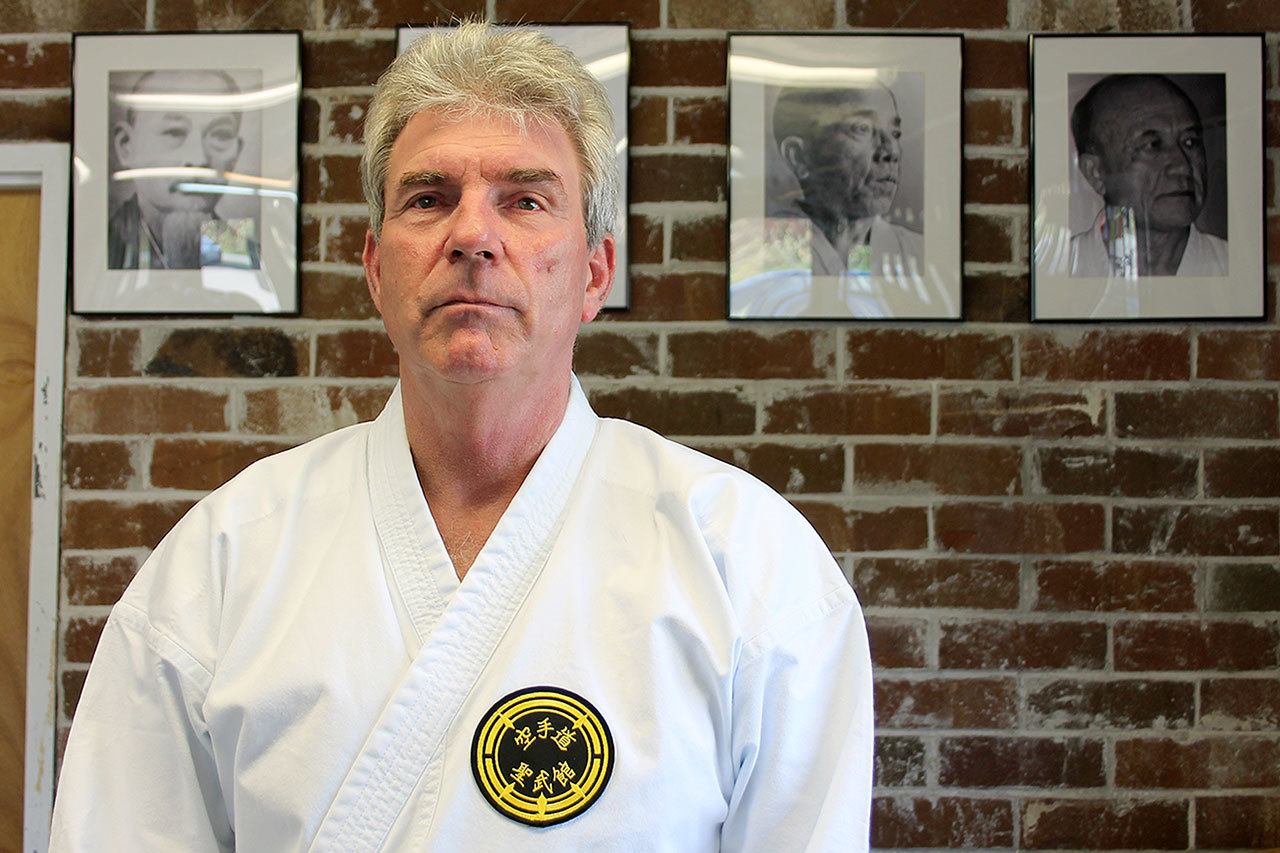In Bayview just south of Highway 525, an unassuming banner that reads “Traditional Okinawan Karate-Do” hangs over the entrance to a tiny storefront.
Inside the tight space, one can find Kyoshi Warren Berto, South Whidbey’s own karate master, or “master instructor” when translated from Kyoshi. And although the average South Ender may not be familiar with the name, the title of karate master is not an exaggeration.
“Sensei Berto is a master of karate,” Butch Donaldson, a sempai or senior student said. “He’s actually the fourth highest rank in the world in our style.”
Berto is part of the Shorin Ryu Seibukan karate lineage, a traditional form that originated from the culturally distinct Southern-most Japanese island of Okinawa. His connection to the lineage is direct; Berto’s sensei is the head instructor of the style, Sensei Zenpo Shimabukaro, the son of founder Zenryo Shimabukaro. Shimabukaro is based in Okinawa to this day, and Berto regularly makes trips across the Pacific Ocean with his students to train with the grand master. He’s been to the Southern Japanese prefecture 33 times, and keeps a close relationship with Shimabukaro.
“We both liked each other and he was able to control me,” Berto said. “I was a young and tough man when I met him and he thought that was funny.”
But on Whidbey Island, and at the eight other dojos he started across the western United States, Berto is sensei. The Alaskan native moved to the island in 2002 after visiting his aunt and drawing parallels to the natural setting of Ketchikan, his hometown. He started off supplementing his karate teachings with contracting work painting trailers, but these day Berto is a full-time karate master.
Berto provides world class Seibukan karate instruction to his 25 students at his Bayview dojo. His name is relatively unknown because he doesn’t advertise his dojo. There isn’t a website to find more information, he doesn’t spend money to get the word out and his dojo doesn’t even have an official name that’s advertised.
And according to Berto, the refusal to boast one’s ego is all part of Okinawan karate culture, which is deeply engrained in Okinawan society.
“Advertising for me is a two-edged sword because there is a chance it will feed the ego, which runs counter to the karate precepts I try to live by,” Berto said. “To get to a place where you can see the ego and not be attached can be good, because you learn to focus on what’s important. Karate is a way of life — it teaches self-improvement and self-realization.”
Seibukan karate, the style which Berto teaches students at his Bayview dojo and across the world, is unique in the way blocking, striking and grappling is taught. One of the primary differences is the 45 degree angles made when a Seibukan karate student attacks and defends, as opposed to the linear moves in other forms. Kicks are rarely used, and it’s a never-strike-first style. Those adept at the form are supposed to be able to deal a death blow in one hit, but Berto says students of the art hardly employ their fighting skills.
In fact, training in the Seibukan school changed his own ways.
“Before practicing when I was young, I fought all the time,” Berto said. “I loved to fight. But since I took up Shorin Ryu, I haven’t gotten in a fight.”
His students say that’s a good thing.
“He could kill you with one small blow,” said Kaytee Bierce, a Langley resident who has been Berto’s student for nine years. “He never will, but he can defend himself.”
Berto’s students say his training has not only improved their physicality, but has had positive effects on their mentality and mental wellbeing as well. Bierce said she feels safer walking alone, and has additionally grown more self confident over the years. But perhaps the largest mental lesson of all is understand and adhering to the karate way of life.
“Deeper than exercise is the deep care for human beings, for everything,” Bierce said. “It’s the karate way — to have reverence for everything. You benefit on the inside but you still get a benefit outside.”
Berto’s classes are open to new students, although he doesn’t teach kids’ classes. His training schedule often varies, but a schedule can be found on the dojo’s front window. He typically teaches six days a week, although that changes in the lead up to a visit to Okinawa to see the grand master. The dojo is located at 5826 S. Kramer Road, Langley.


